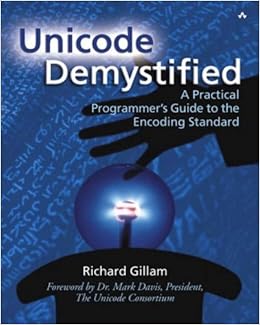
Free Downloads Unicode Demystified: A Practical Programmer's Guide To The Encoding Standard

Unicode provides a unique number for every character a computer deals with, no matter what platform, what program or what language. This text provides a hands-on programmer's guide to Unicode. It offers specific guidance on integrating Unicode with other technologies, including Java.

Paperback: 896 pages
Publisher: Addison-Wesley Professional; 1 edition (September 26, 2002)
Language: English
ISBN-10: 0201700522
ISBN-13: 978-0201700527
Product Dimensions: 7.4 x 1.9 x 9 inches
Shipping Weight: 3 pounds (View shipping rates and policies)
Average Customer Review: 4.6 out of 5 stars See all reviews (7 customer reviews)
Best Sellers Rank: #1,061,896 in Books (See Top 100 in Books) #3 in Books > Computers & Technology > Programming > APIs & Operating Environments > Unicode #12 in Books > Computers & Technology > Programming > Software Design, Testing & Engineering > Coding Theory #482 in Books > Computers & Technology > Computer Science > Systems Analysis & Design

The book has three main parts:(1) Unicode in essence: an architectural overview of the Unicode standard (six chapters) where you also get bits of terminology and history.(2) Unicode in depth: A guided tour of the character repertoire (six chapters) where you get a lot about writing systems that can be represented in Unicode, and less about the Unicode characters.(3) Unicode in action: implementing and using the Unicode standard (five chapters) where you get information aimed at computer programmers that wish to implement parts of the standard or write applications dealing with multilingual text.Though this book is very long (~800 pages) it is still shorter and a lot more clear than the Unicode standard itself (over 1000 pages).Code examples are in Java but they are not ment to be complete solutions and so there is no accompanying website or a CD.Professional programmers are the target audience of this book. The reader is faced with many topics in linguistics, history and data structures. Readers with computer science background would probably appreciate how classic traditional algorithms were adapted and how data structures are used in character sets with a significantly larger number of character than 256.The author of the book states that the book is about "representing written language in a computer", which may be misleading to some readers. The book is about the Unicode standard. Obviously, there are many other ways to represent written language other than the methods described in the book. As chapter 2 teaches... There are always more ways (sometimes better ways) to represent your data.Part 2 of the book will not cover every writing system of the world. A better book for that would be "The world's writing systems".
Unicode Demystified: A Practical Programmer's Guide to the Encoding Standard Professional ASP.NET 2.0 Design: CSS, Themes, and Master Pages (Programmer to Programmer) The Unicode Standard, Version 4.0 The Unicode Standard, Version 3.0 EKG's for Nursing Demystified (Demystified Nursing) Images of All Unicode Characters on Kindle Touch 5.0.0 Images of All Unicode Characters on Kindle Keyboard 3.3 Unicode: A Primer Standard Guide to Small-Size U.S. Paper Money (Standard Guide to Small-Size U.S. Paper Money 1928 to Date) Standard Catalog of Military Firearms: The Collector's Price and Reference Guide (Standard Catalog of Military Firearms: The Collector's Price & Reference Guide) Standard Guide to Small-Size U.S. Paper Money - 1928-Date (Standard Catalog) The Hollywood Standard, 2nd Edition (Hollywood Standard: The Complete & Authoritative Guide to) DB2/Sql: A Professional Programmer's Guide (J Ranade Ibm Series) The RenderMan Companion: A Programmer's Guide to Realistic Computer Graphics COBOL and Visual Basic on .NET: A Guide for the Reformed Mainframe Programmer Programmer's Guide to Internet Mail: SMTP, POP, IMAP, and LDAP (HP Technologies) Conducting the Programmer Job Interview: The IT Manager Guide with Java, J2EE, C, C++, UNIX, PHP and Oracle interview questions! (IT Job Interview series) Programmer's Guide to Fortran 90 Digital Visual Fortran Programmer's Guide (HP Technologies) OCA/OCP Java SE 7 Programmer I & II Study Guide (Exams 1Z0-803 & 1Z0-804) (Certification Press)



